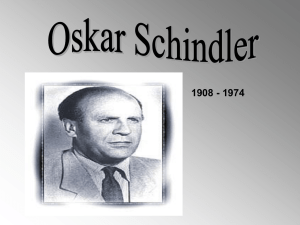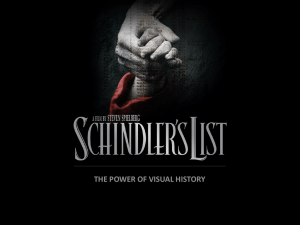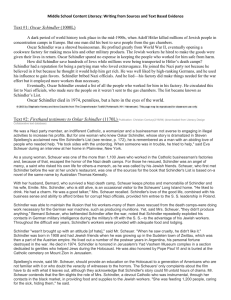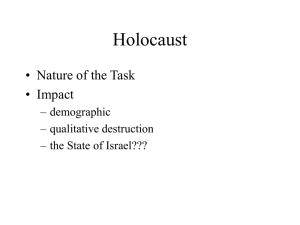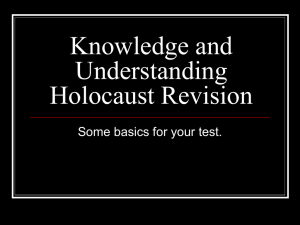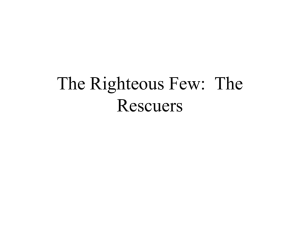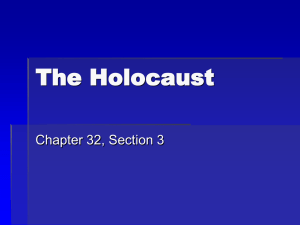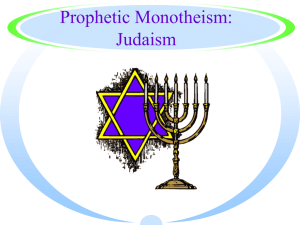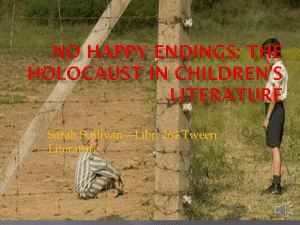Intro to Schindler`s List
advertisement
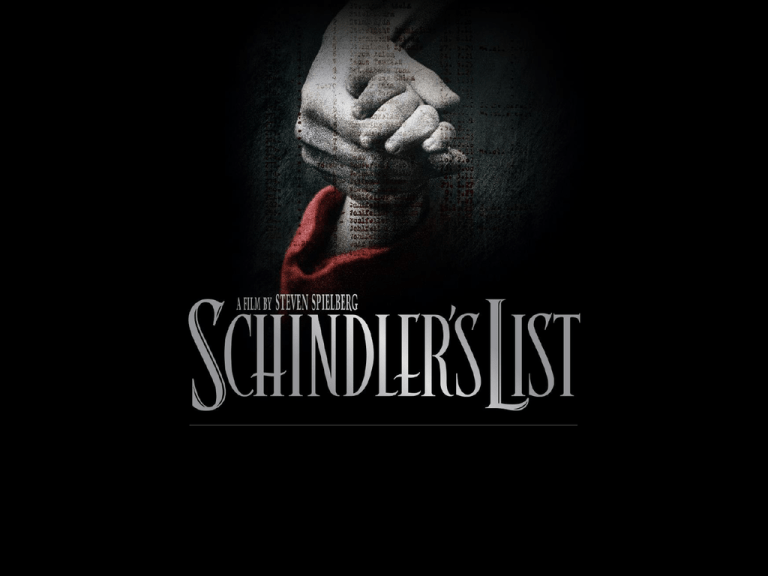
Schindler’s List is one of the most famous films ever made. It won 7 Oscars and 7 BAFTAs when it was released 20 years ago. View Schools Film Montage Watch the trailer What could you work out from the clips? What do you know about the Holocaust? The Holocaust, also known as Shoah (from the Hebrew for ‘the catastrophe’), was the systematic, bureaucratic, state sponsored persecution and slaughter of approximately 6 million Jews by the Nazis and their collaborators during World War II (1939-45). There were about 1.6 million Jewish children, ranging from infants to teens, living in Europe at the start of World War II. Of these, only about 11 percent survived the war. It was not just Jews who were persecuted. Other minorities who were targets of the Nazis included: • • • • • Communists Socialists Gypsies Homosexuals Disabled – physically and mentally. Racial Superiority The Nazis, led by Adolf Hitler, believed that anyone who could be labelled as ‘racially inferior’ needed to be ‘cleansed’ in order to protect the ‘Aryan race’. Anti-Semitism Anti-Semitism, that is prejudice, hatred of, or discrimination against Jews for reasons connected to their Jewish heritage, has existed for centuries. • One of the four sources on the next slides comes from Hitler’s book “Mein Kampf” (My Struggle) published in 1925. Can you tell which one? • The others were written in - 1543, 1881 and 1920. Can you sort out the different sources into their correct order? • Finally, one of them appeared in an English newspaper. Can you tell which one? A Their synagogues should be set on fire and whatever does not burn up should be covered or spread over with dirt so that no one may ever be able to see a stone of it... Their homes should be broken down and destroyed passport and travelling privileges should be absolutely forbidden to the Jews ... all their cash and valuables should be taken from them. To sum up ... if this advice of mine does not suit you, then find a better one and we may all be free of this insufferable devilish burden - the Jews. B I must certainly regard the Jewish race as the born enemy of pure man and of all nobility in them and am convinced that we Germans in particular will be destroyed by them. C This worldwide Jewish conspiracy for the overthrow of civilisation and for the reconstitution of society on the basis of arrested development ... has been steadily growing. D Should the Jew ... triumph over the people of this world, his crown will be the funeral wreath of mankind, and this planet will once again follow its orbit through ether, without any human life on its surface, as it did millions of years ago. And so I believe that my conduct is in accordance with the will of the Almighty creator. In standing guard against the Jew I am defending the handiwork of the Lord. When were they written? 1543, 1881, 1920 or 1925 (from Hitler’s “Mein Kampf”) A Their synagogues should be set on fire and whatever does not burn up should be covered or spread over with dirt so that no one may ever be able to see a stone of it... Their homes should be broken down and destroyed passport and travelling privileges should be absolutely forbidden to the Jews ... all their cash and valuables should be taken from them. To sum up ... if this advice of mine does not suit you, then find a better one and we may all be free of this insufferable devilish burden - the Jews. B I must certainly regard the Jewish race as the born enemy of pure man and of all nobility in them and am convinced that we Germans in particular will be destroyed by them. C This worldwide Jewish conspiracy for the overthrow of civilisation and for the reconstitution of society on the basis of arrested development ... has been steadily growing. D Should the Jew ... triumph over the people of this world, his crown will be the funeral wreath of mankind, and this planet will once again follow its orbit through ether, without any human life on its surface, as it did millions of years ago. And so I believe that my conduct is in accordance with the will of the Almighty creator. In standing guard against the Jew I am defending the handiwork of the Lord. Answers A Their synagogues should be set on fire and whatever does not burn up should be covered or spread over with dirt so that no one may ever be able to see a stone of it... Their homes should be broken down and destroyed passport and travelling privileges should be absolutely forbidden to the Jews ... all their cash and valuables should be taken from them. To sum up ... if this advice of mine does not suit you, then find a better one and we may all be free of this insufferable devilish burden - the Jews. Martin Luther 1543 B I must certainly regard the Jewish race as the born enemy of pure man and of all nobility in them and am convinced that we Germans in particular will be destroyed by them. Richard Wagner 1881 Answers C This worldwide Jewish conspiracy for the overthrow of civilisation and for the reconstitution of society on the basis of arrested development ... Illustrated Sunday Herald 1920 has been steadily growing. D Should the Jew ... triumph over the people of this world, his crown will be the funeral wreath of mankind, and this planet will once again follow its orbit through ether, without any human life on its surface, as it did millions of years ago. And so I believe that my conduct is in accordance with the will of the Almighty creator. In standing guard against the Jew I am defending the handiwork of the Lord. Adolf Hitler 1925 Anti-Jewish Propaganda Propaganda is the use of the Media to aggressively promote one point of view. It involves ‘brainwashing’ of the public and convincing them of an ideological viewpoint. The Nazis used anti-Semitic propaganda over a long period of time to influence the German population into regarding the Jews as untrustworthy and subhuman. This made their persecution of them much easier. A front page caricature from Der Sturmer, No.7, 1935, showing Jewish butchers making sausages from rats. Poster: "Behind the enemy powers: the Jews" Nazi propaganda often portrayed Jews as engaged in a conspiracy to provoke war. Here, a stereotyped Jew conspires behind the scenes to control the Allied powers, represented by the British, American, and Soviet flags. "The Eternal Jew" exhibition Through their control of cultural institutions such as museums, under the Reich Chamber of Culture the Nazis created new opportunities to disseminate antiJewish propaganda. Most notably, an exhibition entitled Der ewige Jude (The Eternal Jew) attracted 412,300 visitors, more than 5,000 per day, during its run at the Deutsches Museum in Munich from November 1937 to January 1938. Special performances by the Poster advertising the antisemitic film Der ewige Jude ("The Eternal Jew"), ca. 1940 Fritz Hippler, the president of the Reich Film Chamber, directed this film with input from German Minister of Propaganda Joseph Goebbels. A pseudo-documentary, it included scenes of Jews shot in the Warsaw and Lodz ghettos by propaganda company crews attached to the German military. The education system was used to promote antiSemitism: ‘In my great educational work I am beginning with the young. My magnificent youngsters! With them I can make a new world!’ Adolf Hitler Membership of the Nazi Teachers’ Association became compulsory after 1933. This made the process of indoctrination much easier for the Nazi Party, with teacher’s being only too willing to pass on Nazi Ideas within the classroom. 32% of teachers by 1936 were also members of the Nazi Party itself. Those teachers who were thought to be lacking in loyalty and not willing to ‘defend without reservation the National-Socialist state’ were sacked. Virtually all Jewish teachers were dismissed in 1933 as it was deemed ‘undesirable’ to allow Jewish teachers to teach ‘Aryan’ pupils. This was made possible by the Law for the Restoration of the Professional Civil Service. Some teachers remained as teachers in Jewish schools until these schools were banned altogether in 1942. Those teachers who taught in ‘Aryan’ schools, however, suffered increasing levels of harassment and by 1935 no Jewish teachers were left in these schools at all. Michael Burleigh and Wolfgang Wippermann, ‘The Racial State’, 1991 ‘Jewish children were often insulted by teachers and pupils, and subjected to malevolent injustices. They had to sit at separate desks, and were often forbidden to play with ‘Aryan’ children during breaks…Jewish children could only escape harassment if they had the chance to attend a Jewish school. Jewish communities, and the Reich Representation of German Jews, did everything possible to expand the existing Jewish schools or to create new ones. In 1942, these were forbidden too.’ Children’s books were also used to spread anti-Semitism. Cover of an antisemitic children's book published by Der Stürmer-Verlag in 1936, entitled Trau keinem Fuchs auf grüner Heid und keinem Jud bei seinem Eid (Trust No Fox in the Green Meadow and No Jew on His Oath). The book contains page after page of antisemitic verses and illustrations. It was widely read and typical of publications used in German classrooms to teach Nazi racial theories. Page from The Poisonous Mushroom This photograph shows a page from one of several anti-semitic children's books published by Julius Streicher's Der StürmerVerlag. The text reads, "The Jewish nose is crooked at its tip. It looks like the number 6." Page from an anti-semitic colouring book One page of an anti-semitic colouring book widely distributed to children with a portrait of a Jew drawn by the German caricaturist known as Fips. In the upper left hand corner is the Der Stürmer logo featuring a Star of David superimposed over a caricature of a Jewish face. The caption under the star reads: "Without a solution to the Jewish question, there will be no salvation for mankind." What was happening to Jewish children in school should not be viewed in isolation. The persecution of Jewish people within Germany accelerated alarmingly between the years 1933-45. 1933 Boycott of Jewish shops, Jewish Civil Servants were dismissed, a ban introduced stopping Jews from inheriting land. Many school text books were altered to contain anti-Semitic messages. 1935 The Nuremberg Laws made it illegal for Aryans to have sexual relations with, or marry, Jews. Jews were no longer allowed to attend public swimming baths, parks and restaurants. Public buildings were closed to Jews and no Jew was allowed to join the army. Jews are to be known as ‘subjects’ not citizens of Germany. 1938 Kristallnacht – Jewish shops, homes and synagogues attacked and some destroyed. Many Jewish people were killed and injured. Jews no longer had the right to choose their child’s name (it had to be chosen from an approved list) and they were no longer allowed to trade. 1941 All Jews had to wear the Star of David (a large yellow six pointed star) on their coats. Ghettoes were set up where Jewish families were forced to settle before being moved on between 1941-45 to Concentration Camps. Jews were not the only group excluded from the vision of the “national community”. The Nazi regime also singled out people with intellectual and physical disabilities. This poster is promoting the Nazi monthly Neues Volk. The caption reads: "This hereditarily ill person will cost our national community 60,000 Reichmarks over the course of his lifetime. Citizen, this is your money." This publication, put out by the Nazi Party's Race Office, emphasised the burden placed on society by those deemed unfit. This marginalisation of those considered undesirable by the Nazi regime led to genocide, murder on a mass scale. Genocide Genocide, as defined by the United Nations in 1948, means any of the following acts committed with intent to destroy, in whole or in part, a national ethnic, racial, or religious group, including: • Killing members of the group; • Causing serious bodily or mental harm to members of the group; • Deliberately inflicting on the group conditions of life calculated to bring about its physical destruction in whole or in part; • Imposing measures intended to prevent births within the group; • Forcibly transferring children of the group to another group. The Nazis used a variety of methods to carry out genocide against the Jews, including: • Einsatzgruppen (mobile killing squads), • gas vans and • gas chambers. Einsatzgruppen These were mobile killing units that carried out mass murder operations in Eastern Europe. Large groups of people were rounded up and forced to dig trenches. They would then stand on the side, or be forced to lie down on top of other bodies in the trenches, and were shot. The Einsatzgruppen kept meticulous records of many of their massacres, and one of the most infamous of these official records is the Jager Report, covering the operation of Einsatzkommando 3 over five months in Lithuania. Written by the commander of Einsatzkommando 3, Karl Jager, it includes a detailed list summarising each massacre, totalling 137,346 victims, and states: "…I can confirm today that Einsatzkommando 3 has achieved the goal of solving the Jewish problem in Lithuania. There are no more Jews in Lithuania, apart from working Jews and their families.“ There seems to be general agreement that the Einsatzgruppen killed about 1.25 million people in the period 1941-42 in Nazi occupied Poland and the USSR. • You are going to watch a film about the Einsatzgruppen. • You are now going to watch a clip of ‘Friends’ actress Lisa Kudrow talking about what she discovered about her family’s experiences in the Holocaust when making her episode of the TV programme ‘Who Do You Think You Are?’ Gas Vans Victims were herded into converted lorries and vans and taken for a drive. The carbon monoxide produced by the engine was then pumped into the van killing all the people inside. The vans were used to kill around 500,000 people, primarily Jews, but also Romani and others. You are going to watch a clip (from 3.46) from Jerry Springer’s episode of ‘Who Do You Think You Are’ which shows what he learned about his grandmother’s death in the Holocaust. Gas Chambers Transport trains delivered Jews, and others, to extermination camps from all over Nazi-occupied Europe, the most infamous of which was Auschwitz in Poland.. When the trains arrived selections took place and about 3/4 of the total were selected to die immediately in the gas chambers. This included almost all children, women with children, all the elderly, and all those who appeared on brief and superficial inspection by an SS doctor not to be completely fit. To prevent panic, the Nazis told them they would be taking a shower. Instead, the disguised showerheads gassed the prisoners to death using Zyklon-B pellets. Zyklon B, a poisonous gas made from hydrogen cyanide crystals, was originally manufactured as a strong disinfectant and for pest control. The SS used Zyklon B for mass extermination in the gas chambers in an effort to satisfy Hitler's demand to annihilate all European Jews. Those inside the gas chambers died within 20 minutes, the speed of death depending on how close the inmate was standing to a gas vent. During the deportation of Hungarian Jews in the spring of 1944, Auschwitz-Birkenau reached peak killing capacity: as many as 6,000 Jews each day. Many of those not killed on arrival in the gas chambers died of starvation, forced labour, lack of disease control, individual executions, and medical experiments. 1.1 million people are thought to have died in Auschwitz (in Poland) alone. Jewish prisoners were forced to work in the crematoria, burning the bodies in ovens. To cover up the workings of the crematoria, the Nazis would kill these workers, known as the Sonderkommando, every few months. According to camp survivors, the smell of burning bodies from the crematoria was constantly in the air. The gas chambers and crematoria enabled the Nazi regime to murder huge numbers of Jews, and others whom they considered enemies such as gypsies, political prisoners, ordinary criminals and Russian POWs. You are going to watch some testimonies of survivors from Auschwitz II Birkenau. Holocaust - Total estimated victims • 4.9 to 6.2 million Jewish people were systematically exterminated during the Holocaust. Estimates of other victims: • Soviet POWs 2–3 million • Ethnic Poles 1.8–2 million • Romani 220,000–1,500,000 • Disabled 200,000–250,000 • Freemasons 80,000 • Homosexuals 5,000–15,000 • Jehovah's 2,500–5,000 Witnesses The events of the Holocaust took place over 70 years ago, so why should we care? ‘Those who cannot remember the past are condemned to repeat it.’ George Santayana philosopher, essayist, poet and novelist. What do you think this means? Watch this interview with Rina Finder, a Holocaust survivor. Can you summarise her message? “It’ll never happen again...”? Genocide is the deliberate and systematic destruction, in whole or in part, of an ethnic, racial, religious, or national group. Can you name any cases of genocide which have taken place since the Holocaust, or which are taking place now? The Bosnian War, or the War in Bosnia and Herzegovina, was an international armed conflict that took place in Bosnia and Herzegovina between March 1992 and November 1995. The Srebrenica Massacre, also known as the Srebrenica Genocide, refers to the July 1995 killing of more than 8,000 Muslim Bosniak men and boys, as well as the ethnic cleansing of 25,000–30,000 refugees in the area of Srebrenica in Bosnia and Herzegovina, by units of the Army of Republika Srpska (VRS) under the command of General Ratko Mladic during the Bosnian War. Graphic chronology on the Srebrenica massacre. In all nearly 8,000 Muslim men and boys were killed in the massacre, the only episode during the war sparked by the break-up of Yugoslavia that was ruled a genocide by two international courts. Tuzla (Bosnia), August 1995: UN camp for refugees fleeing Srebrenica Srebrenica survivor tells of Serb atrocities www.independent.co.ukk A 62-year-old survivor of a massacre at the Bosnian Muslim enclave of Srebrenica has told a U.N. court how he played dead and stumbled across a field of bloody corpses after Serb soldiers gunned down columns of refugees. "They mowed them down and they fell to the ground," said the witness, whose identity was concealed. "You could hear the bullets hitting the bodies ... the air was filled with dust." Other refugees who survived the execution and tried to flee were hunted down and murdered, he added. Towards the end of the 1992-95 Bosnian war, Serb forces broke through U.N. defense posts surrounding the enclave and slaughtered at least 7,500 Muslim men and boys, prosecutors say. The witness said he was held with a group of about 250 men and boys in a tiny room near the town of Pilica, where detainees as old as 80 years old were starved, beaten, killed and intimidated by a handful of Serb soldiers. The men were bound and driven by bus to the site of a military agricultural centre known as Branjevo farm, where a Serb soldier led an execution squad. "We were ordered to turn our backs and lined up ... then he ordered us to lie down and, at that moment, a burst of fire came," he said. Grazed by a bullet, the witness lay quietly among the dead, while executioners finished off those still breathing. One said: I'm still alive, kill me," the witness said, adding that the man was killed with a single bullet through the head. "I estimate between 1,000 and 1,500 were dead when the shooting stopped," he said. "One man tried to flee, because he preferred a bullet in the back than genocide." Just before escaping through the woods, he claimed to have heard a Serb soldier saying: "We have committed genocide ... like in 1941." 1. Countryside around Srebrenica. 2. The outskirts burn. 3. Serb tanks fire on Srebrenica. 4. Ratko Mladic, indicted Serb war criminal, arrives to take charge of Srebrenica. "On to Potocari!" Mladic is shouting - he wants to occupy the Dutch UN base immediately. 5. Mladic and his troops stroll through downtown Srebrenica. 6. Potocari: the Dutch UN base. The ribbon across the main entrance marks the point at which many of the men were separated from women and turned over to the Serbs for eventual execution. 7. The refugees are evacuated as a group from the Potocari base. 8. A Serb officer outside the gates (top left) gestures for the men to be separated from the women. 9. Men of all ages are marched away to the trucks. A voice commands, "Follow him! Behind him! ... No, no, you lot to the left ... One by one." 10. Men are loaded onto the trucks. 11. Dutch Officer at Srebrenica. "When I was standing there, and the men and the women were separated, I felt like a combination of Schindler's List and Sophie's Choice was passing in front of me. It was terrible to be aware of this and not be able to do something ..." 12. The Warehouse. Commentator: "Some of the men from the town were taken to a large agricultural warehouse. A few of them survived." 13. A survivor of the massacre. "The Serbs started shooting at us with everything they had, inside and outside the warehouse. People were dropping all over the place." 14. Aftermath of the warehouse massacre. 15. The mass graves. “Remember. Remember those appalling days which make the world forever bad... Only a matter of days separate this from acts of torture now.” ‘Shooting Stars’ – Carol Ann Duffy Other recent cases of genocide: • 1994 - An estimated 800,000 Tutsis and moderate Hutus died in the genocide in Rwanda. • 2010 - The International Criminal Court issued an arrest warrant for the President of Sudan, Omar al-Bashir, on genocide charges. He is accused of waging a campaign against the citizens of the Sudanese region of Darfur. Some 300,000 people are said to have died and millions have been displaced in a decade of fighting there. What has this got to do with you? Answer yes or no to each of the following questions. Answer truthfully. It is for your eyes only! Have you ever: 1. Overheard a joke that made fun of a person of a different ethnic background, race, religion, or sexual orientation? 2. Been the target of name calling because of your ethnic group, race, religion, gender or sexual orientation? 3. Made fun of someone different than you? 4. Left someone out of an activity because they are different than you? Answer yes or no to each of the following questions. Answer truthfully. It is for your eyes only! Have you ever: 5. Not been invited to attend an activity or social function because many of the people there are different from you? 6. Engaged in stereotyping (lumping together all people of a particular race, religion, or sexual orientation? (E.g. White men can’t jump.) 7. Been threatened by someone different from you because of your difference? 8. Committed an act of violence against someone because that person is different from you? Pyramid of hate Genocide Violence Discrimination Acts of Prejudice Prejudiced Attitudes Pyramid of hate The deliberate, systematic extermination of an entire people Genocide Violence against people: threats, assault, terrorism, murder Violence Discrimination Violence against property: arson, desecration (violating the sanctity of a house of worship or a cemetery) Discrimination – employment, housing, educational Harassment (hostile acts based on a person’s race, religion, nationality, sexual orientation or gender) Acts of Prejudice Name calling Ridicule Prejudiced Attitudes Accepting stereotypes Social avoidance Social exclusion Not challenging belittling jokes Telling belittling jokes Scapegoating (assigning blame to people because of their group ) The following poem is about the dangers of not speaking out to protect others from prejudice and discrimination. First they came for the communists, and I did not speak out because I was not a communist. Then they came for the socialists, and I did not speak out because I was not a socialist. Then they came for the labor leaders, and I did not speak out because I was not a labor leader. Then they came for the Jews, and I did not speak out because I was not a Jew. Then they came for me, and there was no one left to speak out for me. The Reverend Martin Niemöller Niemöller was a German Anti-Nazi theologian and Lutheran pastor. He opposed the Nazis' state control of the churches and was imprisoned in Sachsenhausen and Dachau concentration camps from 1937 to 1945. He narrowly escaped execution and survived imprisonment. After his imprisonment, he expressed his deep regret about not having done enough to help the victims of the Nazis. As you watch the film, think about how you will react the next time you hear someone make a joke or a comment at someone else’s expense. ‘Schindler’s List’ directed by Steven Spielberg What are the dangers / difficulties of making a film about the Holocaust? It is difficult to capture the events – the scale of what happened is so unimaginable that it is hard for the filmmaker to present it in a way that the viewer can understand. Spielberg had to work out how create a film that the audience could relate to without over-simplifying what happened. Steven Spielberg has said that the Holocaust is too abstract, too difficult for us to understand. He has also said that he felt that the story of Oskar Schindler provided “an avenue into a subject that is too horrendous for words, let alone pictures.” What do you think he means by this? The film tells the story of Oskar Schindler (28 April 1908 – 9 October 1974), an ethnic German industrialist, German spy, and member of the Nazi party. However, when Schindler died in 1974 he was buried on Mount Zion in Jerusalem, Israel, the only member of the Nazi Party to be honoured in this way. In 1962 a tree was planted in Oskar Schindler’s honour in the Avenue of the Righteous at the Yad Vashem Holocaust museum in Jerusalem. In 1993 both Oskar and his wife Emilie were officially recognised by Yad Vashem as Righteous Among the Nations, an award bestowed by the State of Israel on nonJews who took an active role to rescue Jews during the Holocaust. The film tells the story of what Schindler did to earn this award. He is credited with saving the lives of 1,200 Jews during the Holocaust by employing them in his enamelware and ammunitions factories, which were located in what is now Poland and the Czech Republic respectively. Today there are more than 7,000 descendants of the Schindler-Jews living in US and Europe, many in Israel. In 1980, Australian author Thomas Keneally by chance visited Poldek Pfefferberg's luggage store in Beverly Hills while en route home from a film festival in Europe. Pfefferberg was one of the ‘Schindlerjuden’, as the Jews saved by Schindler were known. He took the opportunity to tell Keneally the story of Oskar Schindler. He gave him copies of some materials he had on file, and Keneally soon decided to make a fictionalised treatment of the story. After extensive research and interviews with surviving Schindlerjuden, Keneally’s historical novel Schindler’s Ark (published in the United States as Schindler's List) was published in 1982. The novel was adapted into the 1993 film Schindler’s List by Steven Spielberg. Both the book and the film reflected his life as an opportunist initially motivated by profit who came to show extraordinary initiative, tenacity, and dedication in order to save the lives of his Jewish employees. Liam Neeson was nominated for the Academy Award for Best Actor for his portrayal of Schindler in the film, which won seven Oscars, including Best Picture. Was Oskar Schindler a hero? Was Oskar Schindler a hero? Reasons against • Schindler joined the Nazi party in 1939. • He was a womaniser and a playboy. • One biographer claims that he helped the Nazi party to plan the invasion of Poland. Was Oskar Schindler a hero? Reasons against • He worked as a Nazi spy. • Several of the lists were not written by Schindler, but by Marcel Goldberg, a corrupt Jewish member of the security police. Was Oskar Schindler a hero? Reasons for • Because of the actions that he took, over 1,100 people survived the Holocaust. • He moved hundreds of his workers to Czechoslovakia where they were safer. • He put himself in danger by taking action to protect his workers. Was Oskar Schindler a hero? Reasons for • He treated his workers with respect, providing food, healthcare and allowing people to practice their religion. • He spent his fortune to save his workers. • Many of his former workers consider him to be a hero. How can we make sense of this? Does it mean that Schindler was not really a hero? Can heroes have flaws? How did Spielberg approach telling Schindler’s story? Spielberg had to use a range of techniques to engage the audience in Schindler’s story. Throughout the film there is a continual emphasis on ensuring that the audience engage with the characters as individuals: • we see the relationships between the Jews working for Schindler, • we know them by name, • there are people of all ages. What effect do think this will have on the viewer? This enables the audience to identify with them, will them to survive and feel triumphant when they do. When we see the survivors and their families laying rocks on Schindler’s grave at the end this reinforces the truth in the story and the idea that these are people that we can relate to. Why was the film ‘Schindler’s List’ made? Which of the following arguments do you think are most convincing? Why was the film ‘Schindler’s List’ made? Steven Spielberg, who directed Schindler’s List, comes from a Jewish family. Some of his relatives died in the Holocaust. The film was made to tell the story of Oskar Schindler. When Oskar Schindler died in 1974 he was penniless and almost unknown. Why was the film ‘Schindler’s List’ made? Schindler’s List was made to make money. It made over $320 million worldwide. The main purpose of any film is to entertain its audience. Schindler’s List won many awards, including seven Academy Awards and seven BAFTAs. Why was the film ‘Schindler’s List’ made? Schindler’s List was made to help people to understand what happened during the Holocaust. Steven Spielberg used the profits from Schindler’s List to set up the Shoah Foundation. The Shoah Foundation has brought together over 52,000 interviews with people who survived the Holocaust. Why was the film ‘Schindler’s List’ made? Schindler’s List was based on a novel by Thomas Keneally called Schindler’s Ark. A Holocaust survivor called Poldek Pfefferberg persuaded Keneally to write about Oskar Schindler and Spielberg to make a film based on the book. The novel is based on interviews with over fifty Jews who worked in Schindler’s factories. • Steven Spielberg, who directed Schindler’s List, comes from a Jewish family. Some of his relatives died in the Holocaust. • The film was made to tell the story of Oskar Schindler. When Oskar Schindler died in 1974 he was penniless and almost unknown. • Schindler’s List was made to make money. It made over $320 million worldwide. • The main purpose of any film is to entertain its audience. • Schindler’s List won many awards, including seven Academy Awards and seven BAFTAs. • Schindler’s List was made to help people to understand what happened during the Holocaust. • Steven Spielberg used the profits from Schindler’s List to set up the Shoah Foundation. The Shoah Foundation has brought together over 52,000 interviews with people who survived the Holocaust. • Schindler’s List was based on a novel by Thomas Keneally called Schindler’s Ark. A Holocaust survivor called Poldek Pfefferberg persuaded Keneally to write about Oskar Schindler and Spielberg to make a film based on the book. The novel is based on interviews with over fifty Jews who worked in Schindler’s factories. Steven Spielberg uses a number of techniques in Schindler’s List to help the viewer to understand the horror of the Holocaust. Black and White film Almost all of the film was shot in black and white. Why do you think Spielberg chose to do this? What effect do you think it will have on you as a viewer? Black and White film Spielberg has said that he felt that there was “more truth in black and white.” What do you think he meant? Do you agree? Black and White film Spielberg has explained that he felt that it was more appropriate to the time for the film to be shot in black and white. He has said that since his mental images of the Holocaust were in black and white from photographs, that there was “more truth in black and white.” Black and White film It also gives the film more of a documentary feel, which adds weight to the story. Cinematographer Janusz Kamiński said that he wanted to give a timeless sense to the film, so the audience would "not have a sense of when it was made." Cinematography Spielberg decided not to plan the film with storyboards and to shoot the film like a documentary. Forty percent of the film was shot with handheld cameras and the modest budget of $25 million meant the film was shot quickly over seventy-two days. Cinematography Spielberg felt that this gave the film "a spontaneity, an edge, and it also serves the subject." Spielberg said that he "got rid of the crane, got rid of the Steadicam, got rid of the zoom lenses [and] got rid of everything that for me might be considered a safety net." Occasional use of colour Whilst the film is mainly shot in black and white, there is very occasional use of colour. Look out for these as you watch the film. Occasional use of colour The opening scene is in colour but then fades to black and white. Why do you think Spielberg chose to do this? This gives the viewer a sense of going back in time. Occasional use of colour The other most obvious use of colour is in the red coat of a small girl. We see her a few times in the film and she is used to represent: - the innocence of the Jewish people and - Schindler’s changing attitude towards what was happening. Occasional use of colour Colour is also used for candles at the end of the film. Spielberg has said that these are to represent a glimmer of hope. The story of individuals Schindler’s List teaches us about the Holocaust through the story of individuals. Is it strange that Steven Spielberg chose a story with a positive outcome to show audiences about the Holocaust? What effect do you think this has? The final scene The film closes with some of the people that Schindler saved visiting Oskar Schindler’s grave with their families. • How do you think this will reinforce the audience’s engagement with the characters? • How do you think this scene will make you feel? The story of individuals Steven Spielberg feels that visual history is very important. He invested all of the money made by Schindler’s List in setting up the Shoah Foundation, which teaches people about the Holocaust through the stories of survivors. The Shoah Foundation has collected almost 52,000 video testimonies from survivors of the Holocaust, plus survivors of more recent acts of genocide. The story of individuals • Spend some time looking at the clips from The Shoah Foundation website • Why do you think Spielberg felt that it was so important to capture these stories? • What impact do they have? Watching the Film While you watch the film you are going to look out for Themes and Motifs. Schindler’s List - Themes and Motifs Theme - an idea or concept that is central to a story. Motif - a dominant or recurring idea in an artistic work. Schindler’s List - Themes and Motifs There are many interesting themes and motifs in the film. The triumph of good over evil Lists Respect for life The power of the individual Trains Possessions Collective responsibility Knowledge and denial The girl in the red coat Schindler’s List - Themes and Motifs You will each be given a card with a different theme / motif on it. You are going to look out for examples of this aspect while you are watching the film and will take notes on this. Be prepared to feedback on this theme / motif to the rest of the class once we have watched the film.
